Using carbon nanotubes, Rice University scientists, Bruce Weisman and Satish Nagarajaiah, have developed a new class of paint named ‘strain paint,’ which is capable of detecting strain in airplanes, bridges and buildings.
 Rice University Professor Bruce Weisman introduced the idea of strain paint for finding weaknesses in materials with this slide from a presentation to NASA in 2010. (credit:Bruce Weisman/Rice University)
Rice University Professor Bruce Weisman introduced the idea of strain paint for finding weaknesses in materials with this slide from a presentation to NASA in 2010. (credit:Bruce Weisman/Rice University)
The researchers believe that their strain paint will be helpful in detecting deformations in structures such as airplane wings. This composite coating can be read with the help of a handheld infrared spectrometer. The study findings have been reported online in Nano Letters, a journal of the American Chemical Society.
Using this novel paint, it is possible to detect the signs of deformation in a material much earlier than the impact becomes detectable to the naked eye, and most importantly without contacting the structure. Moreover, the nanotube-based system is capable of measuring strain along any direction and at any spot.
Bruce Weisman headed the invention and analysis of near-infrared semiconducting carbon nanotube fluorescence in 2002. Since then, Weisman has devised and utilized innovative optical tools to study the physical and chemical properties of nanotubes. Satish Nagarajaiah and his colleagues headed the strain sensing development for monitoring structural integrity at the macro level utilizing carbon nanofilms’ electrical properties in 2004. Since then, Nagarajaiah has been working on advanced strain sensing methods utilizing different nanomaterials.
Nanotube fluorescence demonstrates large, detectable wavelength changes when the tubes get deformed due to compression or tension. Therefore, the nanotube-based paint will experience the same strain encountered by the coated surface, thus enabling to detect changes occurring underneath.
Nagarajaiah informed that this non-contact technique enables airplane technicians to direct the laser at any location on the wing and obtain a strain chart along any direction. It is possible to impart multifunctional properties to this strain paint for specific applications. This novel paint can be utilized as a protective film to prevent corrosion and or can improve the strength the of base material.
According to Weisman, further research is needed before the commercialization of this paint. It is necessary to optimize information of the paint’s preparation and composition and to find the optimal method to coat this paint over the surfaces to be monitored. It is also important to understand the impact of interactions between the nanotubes, the substrate, and the polymeric host on the long-term stability and reproducibility of the spectral changes.